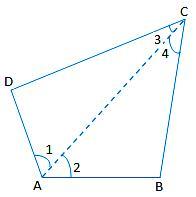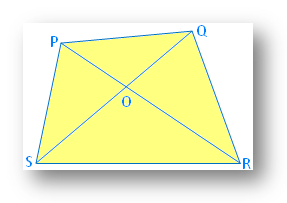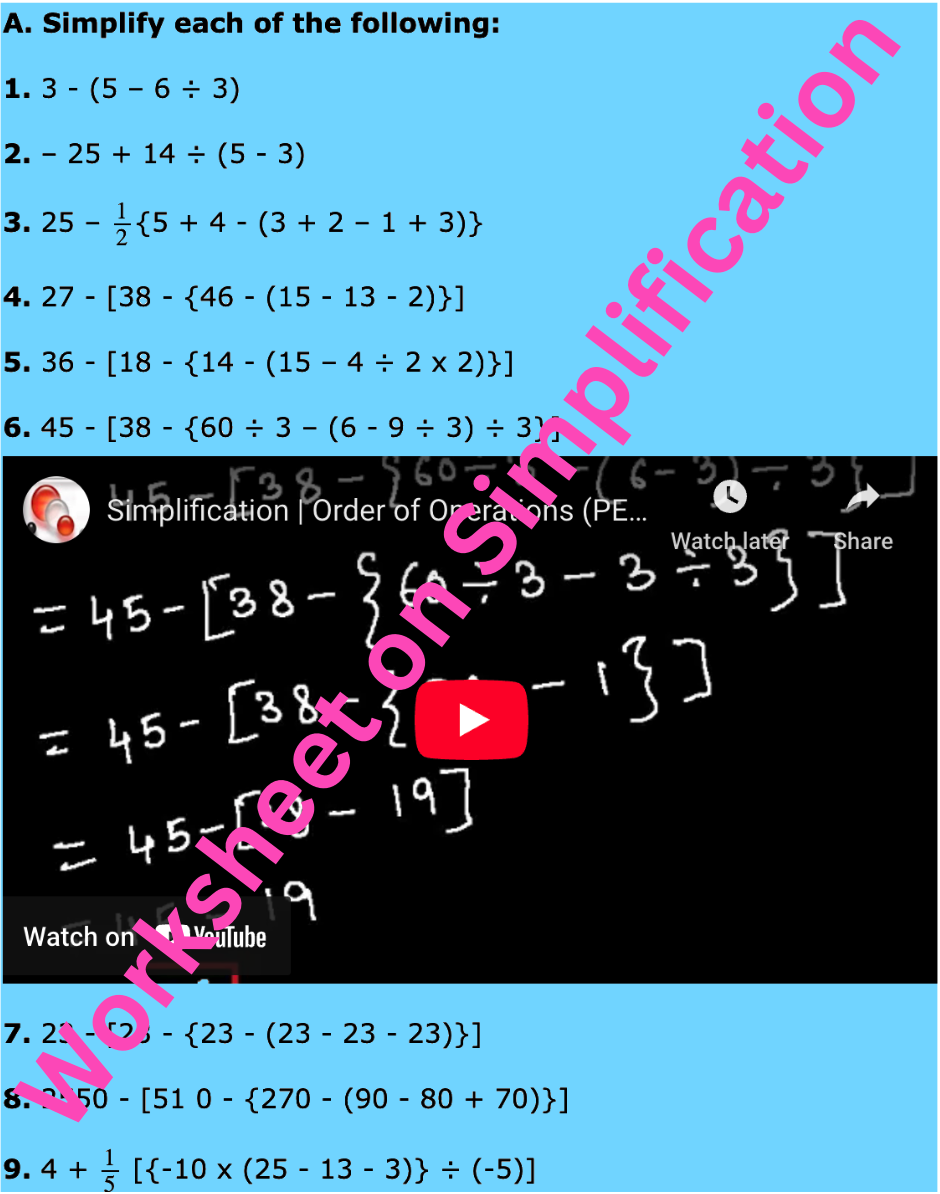Angle Sum Property of a Quadrilateral
Theorem and Proof of angle sum property of a quadrilateral.
Prove that the sum of all the four angles of a quadrilateral is 360°.
Proof: Let ABCD be a quadrilateral. Join AC.
Clearly, ∠1 + ∠2 = ∠A ...... (i)
And, ∠3 + ∠4 = ∠C ...... (ii)
We know that the sum of the angles of a triangle is 180°.
Therefore, from ∆ABC, we have
∠2 + ∠4 + ∠B = 180° (Angle sum property of triangle)
From ∆ACD, we have
∠1 + ∠3 + ∠D = 180° (Angle sum
property of triangle)
Adding the angles on either side, we get;
∠2 + ∠4 + ∠B + ∠1 + ∠3 + ∠D = 360°
⇒ (∠1 + ∠2) + ∠B + (∠3 + ∠4) + ∠D = 360°
⇒ ∠A + ∠B + ∠C + ∠D = 360° [using (i) and (ii)].
Hence, the sum of all the four
angles of a quadrilateral is 360°.
Solved examples of angle sum property
of a quadrilateral:
1. The angle of
a quadrilateral are (3x + 2)°, (x – 3), (2x + 1)°, 2(2x + 5)° respectively.
Find the value of x and the measure of each angle.
Solution:
Using angle sum property of quadrilateral, we get
(3x + 2)°+ (x – 3)° + (2x + 1)° + 2(2x + 5)°= 360°
⇒ 3x + 2 + x - 3 + 2x + 1 + 4x + 10 = 360°
⇒ 10x + 10 = 360
⇒ 10x = 360 – 10
⇒ 10x = 350
⇒ x = 350/10
⇒ x = 35
Therefore, (3x + 2) = 3 × 35 + 2 = 105 + 2 = 107°
(x – 3) = 35 – 3 = 32°
(2x + 1) = 2 × 35 + 1 = 70 + 1 = 71°
2(2x + 5) = 2(2 × 35 + 5) = 2(70 + 5) = 2 × 75 = 150°
Therefore, the four angles of the quadrilateral are 32°, 71° 107°, 150° respectively.
2. In a quadrilateral PQRS, PQ + QR + RS + SP < 2 (PR + QS).
Solution:
In ∆POS, PO + OS > PS …………… (i)
In ∆SOR, SO + OR > SR …………… (ii)
In ∆QOR, QO + OR > QR …………… (iii)
In ∆POQ, PO + OQ > PQ …………… (iv)
(i) + (ii) + (iii) + (iv) (Using triangle inequality property)
PO + OS + OS + OR + OQ + OR + OP + OQ > PS + SR + QR + PQ
⇒ 2 (OP + OQ + OR + OS) > PQ + QR + CS + DP
⇒ 2 [(OP + OR) + (OQ + OS)] > PQ + QR + CS + DP
⇒ 2 (PR + QS) > PQ + QR + RS + SP
The above examples will help us to solve various types of problems based on angle sum property of a quadrilateral.
7th Grade Math Problems
8th Grade Math Practice
From Angle Sum Property of a Quadrilateral to HOME PAGE
Didn't find what you were looking for? Or want to know more information about Math Only Math. Use this Google Search to find what you need.
Recent Articles
-
Counting Numbers from 1 to 50 | Match the Number | Missing Numbers
Apr 04, 25 03:46 PM
In counting numbers from 1 to 50, recognize the numbers, count and then join the numbers in the correct number order. Here we mainly need eye-hand coordination to draw the picture and maintain the num -
Counting Eleven to Twenty with Numbers and Words |Numbers from 11 - 20
Apr 04, 25 03:21 PM
Counting eleven to twenty with numbers and words are explained below. One ten and one more is eleven. Eleven comes after ten. One ten and two more is twelve. Twelve comes after eleven. -
5th Grade BODMAS Rule Worksheet | PEMDAS | Order of operations|Answers
Apr 03, 25 03:11 PM
In 5th Grade BODMAS Rule Worksheet you will get different types of problems on mathematical expressions involving different operations, mathematical expression with 'brackets' and 'of' and simplifying… -
Worksheet on Simplification | Simplify Expressions | BODMAS Questions
Apr 03, 25 02:58 PM
In worksheet on simplification, the questions are based in order to simplify expressions involving more than one bracket by using the steps of removal of brackets. This exercise sheet -
Divisible by 2 Video |Test of Divisibility by 2 Trick| Rules| Examples
Apr 03, 25 10:25 AM
A number is divisible by 2 if the digit at unit place is either 0 or multiple of 2. So a number is divisible by 2 if digit at its units place is 0, 2, 4, 6 or 8.







New! Comments
Have your say about what you just read! Leave me a comment in the box below. Ask a Question or Answer a Question.